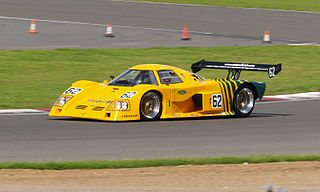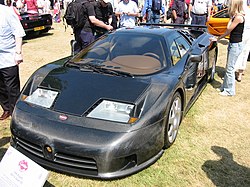
Automobiles Ettore Bugatti was a German then French manufacturer of high-performance automobiles. The company was founded in 1909 in the then-German city of Molsheim, Alsace, by the Italian-born industrial designer Ettore Bugatti. The cars were known for their design beauty and numerous race victories. Famous Bugatti automobiles include the Type 35 Grand Prix cars, the Type 41 "Royale", the Type 57 "Atlantic" and the Type 55 sports car.

Sports car racing is a form of motorsport road racing which utilises sports cars that have two seats and enclosed wheels. They may be purpose-built prototypes or grand tourers based on road-going models. Sports car racing is one of the main types of circuit auto racing, alongside open-wheel racing, touring car racing and stock car racing. Sports car races are often, though not always, endurance races that are run over particularly long distances or large amounts of time, resulting in a larger emphasis on the reliability and efficiency of the car and its drivers as opposed to outright car performance or driver skills. The FIA World Endurance Championship is an example of one of the best known sports car racing series.

The Porsche 961 was a racing car built by Porsche and based on their 959 sports car. It was intended for Group B sports car racing, complementing the purpose-built 956 and 962C which ran Group C in the World Sports-Prototype Championship. The 961 project was short-lived, running only three races and seeing the construction of only one car. Plans to sell the car to customers were scrapped when the Group B class was canceled.

The Bugatti EB 110 is a mid-engine sports car produced by Bugatti Automobili S.p.A. from 1991 until 1995, when the company was liquidated. A small number of post-production cars were completed afterwards, with the last one built by Dauer in 2002 and another unfinished example completed in 2019. It was the only production model made by Romano Artioli's Italian incarnation of Bugatti.

The Porsche 935 is a race car that was developed and manufactured by German automaker Porsche. Introduced in 1976 as the factory racing version of the 911 (930) Turbo and prepared for FIA-Group 5 rules, it was an evolution of the Carrera RSR 2.1 turbo prototype, the second place overall finisher in the 1974 24 Hours of Le Mans.

Zakspeed is a motor racing team from Germany, founded in 1968 by Erich Zakowski and then run by his son Peter Zakowski. It is based in Niederzissen, Rhineland-Palatinate, around 25 kilometres (16 mi) from the Nürburgring circuit.

A Le Mans Prototype (LMP) is a type of sports prototype race car used in various races and championships, including the 24 Hours of Le Mans, FIA World Endurance Championship, IMSA SportsCar Championship, European Le Mans Series, and Asian Le Mans Series. Le Mans Prototypes were created by the Automobile Club de l'Ouest (ACO). The technical requirements for an LMP include bodywork covering all mechanical elements of the car. As of 2023, there are two classes within Le Mans Prototypes, designated LMP2 and LMP3.

The Porsche 962 is a sports prototype racing car designed and built by Porsche. Created to replace the Porsche 956, 962 was introduced at the end of 1984 and replaced the 956 in the IMSA's GTP class in 1985 due to regulation changes obsoleting the 956. It was also introduced in the World Sportscar Championship's Group C category in 1984. Over its decade-long career, the car in its Group C form won the 24 Hours of Le Mans twice, with a derivative of the car, the Dauer 962 Le Mans, winning a further title in 1994. In total, the 962 scored nineteen total constructor's championships across various series. The 962's successor was the Porsche WSC-95, introduced for the 1996 24 Hours of Le Mans, but did not receive factory backing or support.

Group C was a category of sports car racing introduced by the FIA in 1982 and continuing until 1993, with Group A for touring cars and Group B for GTs.

The 1994 24 Hours of Le Mans was the 62nd Grand Prix of Endurance, and took place on 18 and 19 June 1994.
Konrad Motorsport is an auto racing team initially from Austria, but now based in Germany. Founded by Austrian racer Franz Konrad in 1976, the team has mostly run Porsches, although they have also run Ferraris, Lamborghinis, and Saleens over their existence.

Joest Racing is a German sports car racing team that was established in 1978 by former Porsche works racer Reinhold Joest. Their headquarters are in Wald-Michelbach, Germany.
Group 5 was an FIA motor racing classification which was applied to four distinct categories during the years 1966 to 1982. Initially Group 5 regulations defined a Special Touring Car category and from 1970 to 1971 the classification was applied to limited production Sports Cars restricted to 5 litre engine capacity. The Group 5 Sports Car category was redefined in 1972 to exclude the minimum production requirement and limit engine capacity to 3 litres. From 1976 to 1982 Group 5 was for Special Production Cars, a liberal silhouette formula based on homologated production vehicles.
The Konrad KM-011 was a sports prototype built for Group C racing in the 1991 World Sportscar Championship season. The car was part of a brief partnership between Konrad Motorsport and Lamborghini.

The Dauer 962 Le Mans is a sports car based on the Porsche 962 Group C racing car. Built by German Jochen Dauer's Dauer Racing, a racing version of this car went on to win the 1994 24 Hours of Le Mans with the support of Porsche in LMGT1 group.

Brun Motorsport GmbH was a Swiss auto racing team founded by driver Walter Brun in 1983. They competed as a Porsche privateer team in sports car racing for their entire existence, running in a multitude of international championships. They notably won the World Sportscar Championship in 1986 and later became a full-fledged chassis constructor. Brun was also briefly part of the EuroBrun Formula One team from 1988 to 1990. The team was eventually dissolved in 1992.
Richard Lloyd Racing (RLR), originally named GTi Engineering, was a British auto racing team created in 1977 by driver Richard Lloyd. Originally named for the Volkswagen Golf GTIs that Lloyd raced in the British Saloon Car Championship (BSCC), they went on to become a successful Porsche privateer in the World Sportscar Championship (WSC). Richard Lloyd Racing eventually folded at the end of the 1990 season due to the increased cost of the World Championship.

The Ford C100 is a sports racing car, initially built and run as a Group 6 car, but later as a Group C car. The C100 was built by Ford in 1981, and initially featured a 4-litre Cosworth DFL V8 engine, which was replaced by a 3.3-litre version of the same engine in 1983, after the car had passed to private hands. Five cars are known to have been built. Although the cars were often very quick in qualifying, reliability problems plagued them, and restricted their successes to two Deutsche Rennsport Meisterschaft victories in 1982, and a single Thundersports victory in 1983.

Group GT1, also known simply as GT1, was a set of regulations maintained formerly by the Fédération Internationale de l'Automobile (FIA), for Grand Tourer racing. The category was first created in 1993, as the top class of the BPR Global GT Series, and was included in the 24 Hours of Le Mans. It fell under FIA regulation from 1997, after the BPR series came under the control of the FIA, becoming known as the FIA GT Championship. The category was dissolved at the end of 2011. The category may be split into four distinctive eras, from its debut in 1993–1996, 1997–1998, 2000–2009, 2010–2011.
Obermaier-Racing GmbH was a German auto racing team and tuning garage founded by Hans Obermaier and Jürgen Lässig. Specializing in Porsches for much of their history, the team competed at the top level of the World Sportscar Championship from 1983 until 1990 before finding success in the various incarnations of the Porsche Carrera Cup. The team was later known as Oberbayern Motorsport before their auto racing activities ceased in 2000.
















